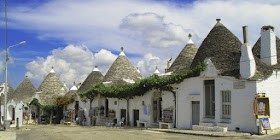The rows of whitewashed pitched-roof abodes are like something out of a fairy-tale. One glance at the Italian village of Alberobello and you might just think you have stumbled on Mediterranean Middle-earth Hobbit dwelling. This argitectural style, known as Trulli, is unique to the Apulia region of Italy. This style of architecture can also be found in the Italian villages of Locorotondo, Fasano, Cisternino and Martina Franca.
In 1644, the King of Naples sent tax collectors intermittently to the
Puglia region, near the town of Alberobello. Although under the rule of
the Spanish, the Kingdom of Naples was a powerful force in Italy at the
time and one of the biggest cities in all of Europe. Fearing the immense power of the Kingdom, the local lord Count
Acquaviva, needed to create a feudal settlement that could be dismantled
easily to avoid a settlement tax. To accomplish that end, he forced
local people into trullo houses that could be easily taken apart.
After years of feudal control by Acquaviva, the town of Alberobello
finally overthrew the count and were granted royal town status by the
King of Naples. Although they threw out their overseer, they kept the
style of their house and the town has remained close to its roots for
the last 200 years (via).
The architectural elements that distinguish Trulli from any other buildings are: the stone arcs, the cones, the ledges, the chimney pots, the gutters, the flat-stone roofs and the pinnacles. Most remarkable is also the symbols (monograms, emblems, initials and magical signs) used mostly on the roofs for decoration.
The whole structure is built with local limestone and no mortar. Made of concentric stone rings, the Trullo's roof is laid on the supporting structure, with a slight overhang towards the interior. The floors are the natural stone. The structure is painted white, while the roof, designed to facilitate the flowing of the rain water, remain unpainted. Rain water is channeled towards an underground cistern. The pinnacle on top of the Trullo is not only for decorative purpose, but it also locks the last layers of stone in place. There are two walls, an interior and an exterior, with the gap in between filled with rubble that serves as an excellent insulation during winter and is cool during summer. The fireplaces and stoves are built into the walls, so no heat is wasted.
Alberobello's unique beauty and characteristics makes it a popular tourist destination. The Trulli represents one of the most extraordinary examples of Italian folk architecture. Alberobello currently has approximately 11 000 inhabitants whereof 1 500 trulli are still lived in. Some have been converted to restaurants, shops holiday houses or hotels. In 1996 it was declared an UNESCO world heritage site.
Sources:
Atlas Obscura
Trullishire












No comments:
Post a Comment